Can My Dog Eat Grapes: A Complete Guide to Grape Toxicity
Transparency matters to us! This post may include affiliate links, which means we earn a small commission if you make a purchase through our recommendations. This is at no additional cost to you. Read our full affiliate disclosure.
You’re slicing up some fresh fruit for a snack when your furry friend gives you those irresistible puppy dog eyes, hoping for a taste. Before you even think about tossing them a grape, you need to know this could be a life-threatening mistake. Can my dog eat grapes safely? The answer is an absolute no.
Even a single grape can be fatal for some dogs, making this seemingly innocent fruit one of the most dangerous foods you can accidentally share with your pet. While many dog parents know chocolate is off-limits, grape toxicity often catches people off guard because these healthy human snacks can cause sudden kidney failure in our four-legged family members.
The scary part is that symptoms may not show up immediately, giving you a false sense of security while serious damage occurs internally. Understanding why grapes are so dangerous and what to do if your dog gets into them could save your pet’s life.
Key Takeaways
- Grapes and Raisins Are Highly Toxic to Dogs: Any amount poses severe risks, including fatal kidney failure, with no known safe threshold for consumption
- All Forms Are Dangerous: Fresh, dried, cooked, peeled, seedless varieties, food recipes, juices, or supplements are all unsafe for dogs to consume
- Delayed Symptoms: Signs of toxicity often develop hours or days after eating grapes, making immediate action critical
- Emergency Veterinary Care Is Essential: There is no antidote, so survival depends on starting professional treatment immediately after suspected ingestion
- Prevention Is Best: Keep grapes, raisins, and related products securely stored and educate everyone in your household about these dangers
Why Grapes Are Toxic to Dogs
Grapes contain mysterious compounds that wreak havoc on your dog’s kidneys, and scientists are still working to identify exactly what makes them so dangerous. Recent research suggests tartaric acid may be responsible for grape toxicity in dogs, though other substances like tannins or flavonoids might also play a role. What makes this toxicity particularly frightening is its unpredictable nature. Some dogs can eat grapes and seem fine initially, while others develop severe kidney failure from just one or two grapes.
The toxic reaction appears to be idiosyncratic, meaning it can affect any dog regardless of age, breed, or size. Dogs cannot process tartaric acid efficiently, allowing it to build up in their system and cause organ damage. This makes every grape consumption a potentially deadly gamble with your pet’s health.
How Toxic Compounds Affect Dogs
When your dog eats grapes, the toxic substances begin attacking kidney cells directly. The compounds cause acute kidney injury by damaging the tiny filtering units in the kidneys, leading to a dangerous buildup of waste products in the bloodstream. As kidney function declines, your dog’s body loses its ability to filter toxins and maintain proper fluid balance.
The damage can happen incredibly quickly. Within hours, kidney cells begin dying, and urine production may slow down or stop completely. This creates a cascade of problems including dehydration, electrolyte imbalances, and uremia, which can lead to seizures, coma, and death if left untreated.
All Related Fruits Are Hazardous
Don’t assume that certain types of grapes are safer than others. All grape varieties including red, green, seedless, peeled, fresh, dried raisins, sultanas, and currants are potentially dangerous. The concentration of toxic compounds may vary, but there’s no way to predict which grapes will cause problems for your specific dog.
Even processed grape products pose serious risks. Grape juice, wine, baked goods containing raisins, and trail mix can all trigger the same toxic reaction. The cooking or drying process doesn’t eliminate the dangerous compounds, making raisins just as hazardous as fresh grapes.
Symptoms and Timeline of Grape Poisoning
Grape poisoning symptoms can be deceptively mild at first, which is why many dog parents don’t realize the severity of the situation until it’s almost too late. The tricky part about grape toxicity is that your dog might seem perfectly fine for hours or even days after eating grapes, leading you to believe everything is okay. However, serious kidney damage may already be occurring beneath the surface, making early intervention absolutely critical for your pet’s survival.
Understanding the progression of symptoms can help you recognize when your dog needs emergency care, even if they seem relatively normal at first glance.
Early Gastrointestinal Signs
The first symptoms typically appear within 6 to 12 hours after eating grapes and usually involve your dog’s digestive system. Vomiting is often the earliest and most common sign, sometimes containing pieces of grapes or raisins that can help confirm what your dog ate. You might also notice diarrhea, loss of appetite, and signs of abdominal discomfort like panting or reluctance to move around.
Drooling excessively and showing signs of nausea are other early warning signs. Some dogs may also experience abdominal pain, appearing hunched or reluctant to be touched around their belly area. These symptoms might seem minor compared to other emergencies, but they signal that toxic processes are already underway in your dog’s system.
Signs of Acute Kidney Injury
As grape toxicity progresses, more serious symptoms begin appearing that indicate kidney damage is occurring. Lethargy and weakness become more pronounced as waste products build up in your dog’s bloodstream. You might notice your dog drinking more water than usual initially, followed by a concerning decrease or complete absence of urination.
Dehydration becomes obvious through dry gums, skin that doesn’t bounce back when pinched, and sunken eyes. In severe cases, dogs may develop tremors, seizures, or bad breath from uremia. The most critical sign is when your dog stops producing urine altogether, indicating complete kidney failure.
Symptom Timeline
The timeline for grape poisoning can vary significantly between dogs, but there’s a general pattern that most cases follow. Gastrointestinal symptoms like vomiting and diarrhea typically appear within 6 to 24 hours, while kidney failure usually develops 24 to 72 hours after consumption. However, some dogs may not show any symptoms for several days, making the situation even more dangerous.
Early treatment during the first few hours offers the best chance of preventing permanent kidney damage. Once kidney failure sets in, the prognosis becomes much more serious, with survival rates dropping significantly. Time is absolutely critical when dealing with suspected grape ingestion.
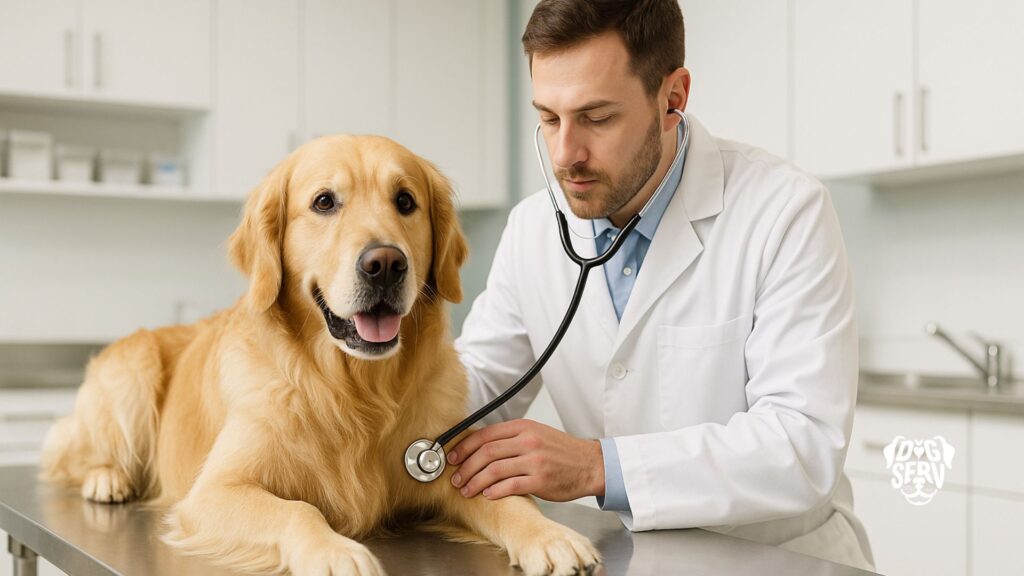
Immediate Actions and Emergency Measures
When you suspect your dog has eaten grapes or raisins, every minute counts toward preventing permanent kidney damage or death. Don’t wait to see if symptoms develop, because by the time obvious signs appear, serious harm may already be occurring inside your pet’s body. Quick action during the first few hours after ingestion offers your dog the best chance of a full recovery, while delays can turn a treatable emergency into a tragic outcome.
The most important thing to remember is that grape toxicity is always a veterinary emergency, not something you can handle safely at home with internet advice or home remedies.
What to Do First
Start by quickly determining what your dog ate, how much, and when they consumed it. If you catch your dog eating grapes in the act, immediately remove any remaining fruit and check their mouth for pieces. Try to estimate the number of grapes consumed and note the time, as this information will be crucial for your veterinarian’s treatment plan.
Contact your veterinarian or animal poison control hotline immediately, even if your dog seems completely normal. Don’t wait for symptoms to appear, as early intervention dramatically improves outcomes. Have your dog’s weight, the estimated amount consumed, and the time of ingestion ready when you call for the most accurate advice.
Veterinary Intervention Steps
Professional treatment for grape toxicity focuses on preventing absorption of remaining toxins and supporting kidney function through aggressive medical care. Your veterinarian may induce vomiting if ingestion occurred within the past few hours and your dog is alert and conscious. This procedure must be done safely by professionals, as improper technique can cause additional complications.
Activated charcoal may be administered to absorb any remaining toxins in the digestive system, followed by aggressive intravenous fluid therapy to flush the kidneys and maintain proper hydration. Blood tests and urinalysis help monitor kidney function, while medications may be given to control nausea and support blood pressure. In severe cases, dialysis might be necessary if kidney function stops completely.
Why Home Remedies Are Not Safe
Never attempt to make your dog vomit at home using hydrogen peroxide, salt, or other substances without veterinary guidance. Improper induction of vomiting can cause additional complications like aspiration pneumonia, especially if your dog is already showing symptoms or is unconscious. Home remedies can also waste precious time that could be spent getting professional treatment.
The “wait and see” approach is particularly dangerous with grape toxicity because symptoms often appear after significant kidney damage has already occurred. Professional veterinary care provides the monitoring, medications, and supportive treatments that home care simply cannot match during this type of emergency.
Prevention and Everyday Safety Practices
Creating a grape-safe environment for your dog requires consistent attention to where these dangerous fruits might be lurking in your daily life. Many dog parents focus on obvious sources like fruit bowls but overlook the countless processed foods, baked goods, and snacks that contain raisins or grapes. Developing good prevention habits protects your pet from both accidental exposure and well-meaning family members who might not understand the dangers.
Prevention becomes even more important when you consider that there’s no safe amount of grapes for dogs, making even tiny exposures potentially life-threatening.
Kitchen and Pantry Safety
Store all grapes, raisins, and related products in sealed containers placed well out of your dog’s reach, including high cupboards or pantries with secure doors. Counter surfing dogs can easily grab grapes left in fruit bowls or open containers, so never leave these items on accessible surfaces, even briefly while you’re cooking or unpacking groceries.
Pay special attention to where you place grocery bags after shopping, as dogs often investigate new smells and could get into grape purchases before you put them away. Create designated safe storage areas for all potentially toxic foods, and make checking these areas part of your regular routine when dog-proofing your home.
Recognizing Hidden Ingredients
Reading ingredient labels becomes crucial when you have dogs, as raisins and grape products hide in surprising places. Trail mix, granola bars, cereals, cookies, fruitcakes, and even some sauces may contain raisins or grape derivatives. Baked goods from bakeries or restaurants may not clearly list all ingredients, making them potential hidden dangers.
Be particularly careful with holiday foods, homemade gifts from friends, and international foods that might use different names for grape products. Currants, sultanas, and Zante currants are all forms of dried grapes that pose the same risks. When in doubt, keep any questionable foods completely away from your dog.
Educating Family and Visitors
Make sure everyone in your household understands that grapes and raisins are completely off-limits for dogs, with no exceptions for special occasions or tiny amounts. Children often want to share their snacks with pets and may not understand why healthy fruits can be dangerous. Create clear rules about what foods can and cannot be shared, and supervise interactions between kids and dogs during snack time.
Inform guests, pet sitters, and dog walkers about grape toxicity before they spend time with your pet. Many people assume that healthy human foods are fine for dogs, so proactive education prevents well-intentioned accidents. Consider posting a list of toxic foods on your refrigerator as a reminder for everyone who might feed your dog.
Veterinary Diagnosis and Management
When you bring your dog to the veterinary clinic for suspected grape ingestion, the medical team will work quickly to assess the situation and begin treatment protocols designed to minimize kidney damage. Professional diagnosis involves more than just confirming what your dog ate; veterinarians must evaluate current kidney function, determine the extent of any existing damage, and create a treatment plan tailored to your pet’s specific needs and timeline since ingestion.
The complexity of grape toxicity treatment requires specialized medical equipment and round-the-clock monitoring that only veterinary facilities can provide.
Diagnostic Tests and Monitoring
Blood work focusing on kidney parameters like creatinine and blood urea nitrogen helps assess current kidney function and establish baseline values for monitoring treatment progress. Urinalysis reveals important information about kidney damage, including protein levels, specific gravity, and the presence of abnormal cells or crystals that indicate injury.
Electrolyte panels check for dangerous imbalances that can occur when kidneys stop functioning properly, while regular monitoring of urine output helps determine if treatment is working. Some cases may require additional tests like blood pressure monitoring or imaging studies to fully evaluate kidney damage and guide treatment decisions.
Treatment Strategies and Recovery
Aggressive intravenous fluid therapy forms the foundation of grape toxicity treatment, helping flush toxins from the system and support kidney function during the critical recovery period. The goal is to maintain adequate kidney blood flow and prevent further damage while the body works to heal injured kidney cells. Medications to control nausea, protect kidney function, and maintain stable blood pressure may also be necessary.
Treatment typically requires hospitalization for 24 to 72 hours with continuous monitoring, as kidney function can change rapidly during this critical period. In severe cases where urine production stops completely, dialysis may be the only option to keep your dog alive while waiting to see if kidney function returns. Recovery depends heavily on how quickly treatment begins and whether permanent kidney damage occurs.
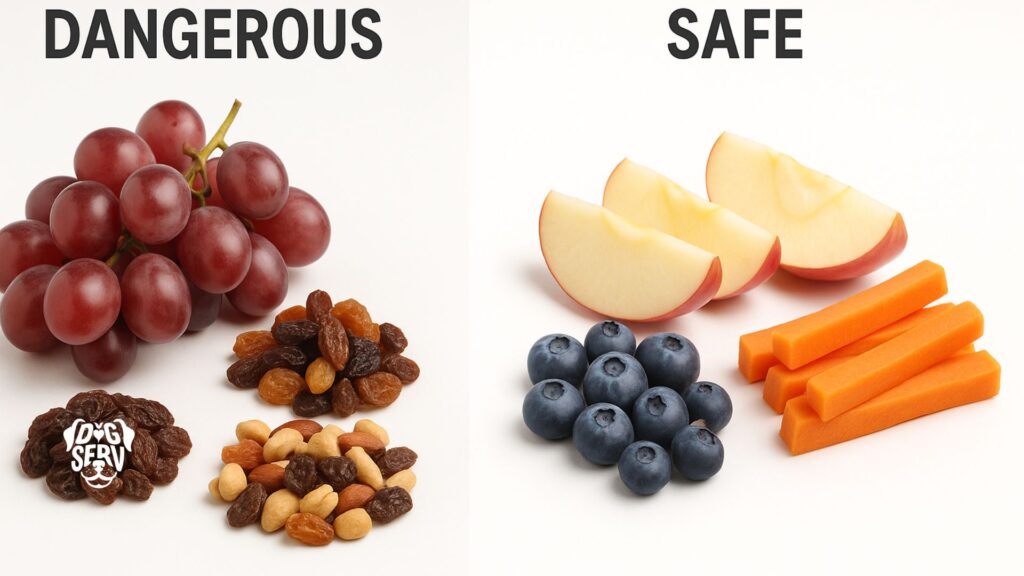
Risk Factors and Special Considerations
While any dog can develop grape toxicity regardless of age, breed, or size, certain factors may make some pets more vulnerable to severe reactions or complications. Understanding these risk factors helps you appreciate why immediate veterinary care is so important, especially for dogs who fall into higher-risk categories. However, it’s crucial to remember that even healthy adult dogs can die from eating grapes, so no dog should ever be considered safe from this toxicity.
Individual sensitivity to grape toxins varies dramatically between dogs, making it impossible to predict which pets will have mild reactions versus life-threatening emergencies.
Puppies and Small Breeds
Smaller dogs and puppies face higher risks because even tiny amounts of grapes represent a larger dose per pound of body weight. A single grape might be insignificant to a 100-pound dog but could be lethal for a 5-pound Chihuahua. Young dogs also have less developed kidney function and may be less able to handle the toxic assault on their developing organ systems.
Puppies tend to be more curious and likely to eat things they find, including dropped grapes or raisins that older dogs might ignore. Their smaller size also means they dehydrate more quickly and can develop dangerous electrolyte imbalances faster than larger dogs when kidney function becomes compromised.
Repeated, Low Dose Exposure
Chronic exposure to small amounts of grapes or raisins may cause cumulative kidney damage over time, even if each individual incident seems minor. Dogs who regularly get into baked goods containing raisins or sneak grapes from fruit bowls may be slowly poisoning themselves without obvious symptoms until kidney damage becomes severe.
This makes prevention even more critical, as you might not realize your dog is being exposed to small amounts regularly. Even dogs who seem to tolerate occasional grape consumption may suddenly develop severe toxicity, as kidney damage can accumulate silently over time before becoming life-threatening.
Underlying Health Conditions
Dogs with pre-existing kidney disease, diabetes, or other metabolic conditions face much higher risks of complications from grape toxicity. Their already compromised organ systems cannot handle the additional stress of toxic exposure, making even small amounts of grapes potentially fatal. Senior dogs often have reduced kidney function even if they seem healthy, putting them at greater risk for severe reactions.
Dehydration from any cause makes grape toxicity worse, so dogs recovering from illness, surgery, or other health problems need extra protection from toxic exposures. Medications that affect kidney function can also increase sensitivity to grape toxins, making prevention absolutely critical for dogs on certain treatments.
Hidden Dangers: Foods and Situations to Avoid
Grape toxicity becomes even more dangerous when you consider how many common foods and situations can expose your dog to these deadly fruits without your knowledge. Many dog parents successfully avoid obvious sources like fruit bowls but get caught off guard by processed foods, restaurant meals, or holiday treats that contain hidden grape products. Developing awareness of these sneaky sources protects your pet from accidental poisoning that could easily be prevented with more careful attention to ingredients and situations.
The challenge is that grape products often appear in foods where you wouldn’t expect to find them, using names that don’t immediately signal danger.
Commercial and Packaged Foods
Trail mix represents one of the biggest hidden dangers because raisins are often mixed with nuts and other ingredients that dogs find irresistible. Granola bars, breakfast cereals, energy bars, and protein snacks frequently contain raisins or other dried grape products that may not be prominently featured on packaging. Even savory foods like stuffing mixes, rice dishes, and certain sauces may include raisins for sweetness.
Baked goods from grocery stores or specialty shops often contain raisins in bread, muffins, cookies, and pastries. Holiday foods like fruitcakes, stollen, and traditional Christmas puddings are particularly dangerous because they’re loaded with various dried fruits including raisins and currants. Always check ingredient lists carefully and assume any mixed food item might contain grape products unless specifically labeled otherwise.
Homemade and Restaurant Meals
Restaurant meals and takeout orders can be particularly dangerous because you can’t control ingredients or get complete ingredient lists. Salads, grain bowls, Middle Eastern dishes, and gourmet preparations may include grapes or raisins for flavor and texture without clear menu descriptions. Even asking servers about ingredients may not give you complete information, as kitchen staff might not know every component of complex dishes.
Homemade meals from friends or family members present similar risks, especially during holidays when people often cook with traditional recipes containing raisins or currants. Well-meaning relatives might not think to mention grape products when they offer to share food with your dog, making prevention education crucial for everyone who might interact with your pet.
Unsafe At-Home Remedies
Never attempt to treat suspected grape ingestion at home using internet advice or folk remedies, as improper treatment can delay professional care or cause additional complications. Making dogs vomit using hydrogen peroxide, salt, or other home methods can be dangerous without veterinary supervision, especially if your dog is already showing symptoms or has other health conditions.
The “wait and see” approach is particularly dangerous because kidney damage often occurs before obvious symptoms appear. Home remedies cannot provide the intensive monitoring, intravenous fluids, and medications that dogs need to survive grape toxicity. Professional veterinary care is always the safest and most effective option for this type of emergency.
Recognizing and Responding to Overconsumption
When your dog consumes a large quantity of grapes or has been eating them over an extended period, the situation becomes even more critical and requires immediate emergency intervention. Large ingestions or repeated exposure dramatically increase the likelihood of severe kidney failure and death, making rapid professional treatment absolutely essential for survival. Understanding the signs that indicate your dog is in serious trouble helps you communicate effectively with veterinary staff and ensures your pet gets the intensive care they need.
Time becomes even more critical with heavy grape consumption, as the toxic load on your dog’s kidneys increases with the amount consumed.
Red-Flag Symptoms
Persistent vomiting that continues despite attempts to rest the stomach signals serious toxicity that requires emergency care. If your dog cannot keep water down or continues retching even with an empty stomach, this indicates severe poisoning that will only get worse without professional intervention. Complete loss of appetite, extreme lethargy, and reluctance to move are also serious warning signs.
The most critical symptom is decreased or absent urination, which indicates kidney failure has already begun. Tremors, difficulty walking, seizures, or collapse signal that toxins have built up to dangerous levels in your dog’s bloodstream. Bad breath with a sweet or chemical smell often indicates uremia, a life-threatening condition caused by kidney failure.
Recovery Outlook
Early, aggressive veterinary treatment offers the best chance of recovery, with most dogs surviving if treatment begins before kidney failure develops. However, the prognosis becomes much more serious once kidney damage occurs, particularly if urine production stops completely. Dogs who receive prompt treatment within the first few hours have much better outcomes than those who don’t get help until symptoms appear.
Recovery may take several days to weeks, depending on the extent of kidney damage and how quickly treatment began. Some dogs recover completely with no lasting effects, while others may have permanent kidney damage requiring special diets and ongoing medical management. The key factors in recovery are the amount consumed, time elapsed before treatment, and individual sensitivity to grape toxins.
Alternative Safe Treats for Dogs
Choosing safe, healthy treats for your dog doesn’t have to be complicated when you know which fruits and vegetables are actually beneficial rather than dangerous. Many dog parents feel overwhelmed by the long list of foods their pets can’t eat, but there are plenty of delicious, nutritious options that make excellent training treats or special snacks. Focus on whole foods that provide vitamins and fiber without the risks associated with grapes and other toxic fruits.
Always introduce new treats gradually and in small amounts to ensure your dog tolerates them well, even when they’re considered safe options.
The safest fruit alternatives include blueberries, which are packed with antioxidants and make perfect training treats due to their small size. Apple slices with seeds removed provide fiber and vitamins while satisfying your dog’s desire for something crunchy and sweet. Bananas offer potassium and natural sweetness, though they should be given in moderation due to their sugar content.
Vegetable options like baby carrots, green beans, and sweet potato chunks provide satisfying crunch and valuable nutrients without toxic risks. Watermelon without seeds makes a refreshing summer treat that most dogs love, while frozen pieces can provide entertainment and cooling on hot days. These alternatives let you share healthy snacks with your pet without worrying about dangerous reactions.
When and Why to Consult a Veterinarian
Building a relationship with a trusted veterinarian provides you with expert guidance for all aspects of your dog’s nutrition and health, including questions about food safety and toxic exposures. Professional veterinary advice becomes invaluable when you’re unsure about specific foods, dealing with a dog who gets into everything, or managing multiple pets with different dietary needs. Regular check-ups also help establish baseline health parameters that can be crucial during emergency situations like grape toxicity.
Don’t hesitate to contact your veterinarian whenever you have concerns about something your dog ate, even if they seem fine at the moment. Professional guidance can help you determine whether emergency treatment is necessary or if monitoring at home is appropriate, potentially saving your pet’s life or preventing unnecessary worry over harmless exposures.
Your veterinarian can provide personalized advice based on your dog’s size, health status, and individual risk factors that generic internet information cannot match.
Frequently Asked Questions Related to Can My Dog Eat Grapes
Q: Can a dog eat a single grape safely?
A: No, there is no known safe amount of grapes for dogs. Even one grape can be fatal for some dogs, making any exposure potentially dangerous regardless of your pet’s size or apparent health.
Q: How quickly do symptoms appear after eating grapes?
A: Gastrointestinal symptoms like vomiting typically appear within 6-24 hours, but kidney failure usually develops 24-72 hours after consumption. Some dogs may not show obvious symptoms for several days while serious damage occurs.
Q: What should I do if my dog eats raisins or grape-containing foods?
A: Contact your veterinarian or animal poison control immediately, even if your dog seems normal. Early intervention dramatically improves outcomes, while waiting for symptoms to appear can be fatal.
Q: Are all types and forms of grapes dangerous for dogs?
A: Yes, all grape varieties including fresh, dried, cooked, seedless, and processed forms like raisins, currants, and sultanas are harmful. Cooking or processing doesn’t eliminate the toxic compounds.
Q: Can dogs recover from grape poisoning?
A: Most dogs recover with fast, aggressive veterinary treatment if kidney failure hasn’t developed. However, the prognosis becomes much more serious once kidney damage occurs, and delayed treatment significantly reduces survival chances.
Protecting Your Dog from Grape Toxicity
Grape toxicity represents one of the most serious food dangers facing our canine companions, but it’s also one of the most preventable with proper knowledge and precautions. Remember that no amount of grapes, raisins, or related products is safe for dogs, making prevention your most powerful tool for protecting your pet. Create grape-safe environments in your home, educate everyone who interacts with your dog, and always choose proven safe alternatives when you want to share healthy treats.
If grape ingestion ever occurs, immediate veterinary care offers the best chance of a positive outcome, while delays can turn a treatable emergency into a tragedy. The investment in prevention and emergency preparedness pays off in years of healthy, happy life with your beloved companion.
At DogServ, we understand the deep bond between dogs and their families, which is why we’re committed to providing the expert guidance and resources you need to keep your pet safe and healthy throughout every stage of their life. From nutrition advice to emergency preparedness, our comprehensive platform connects you with trusted information and professional support when you need it most. Your dog’s safety and well-being deserve nothing less than expert care and reliable guidance.
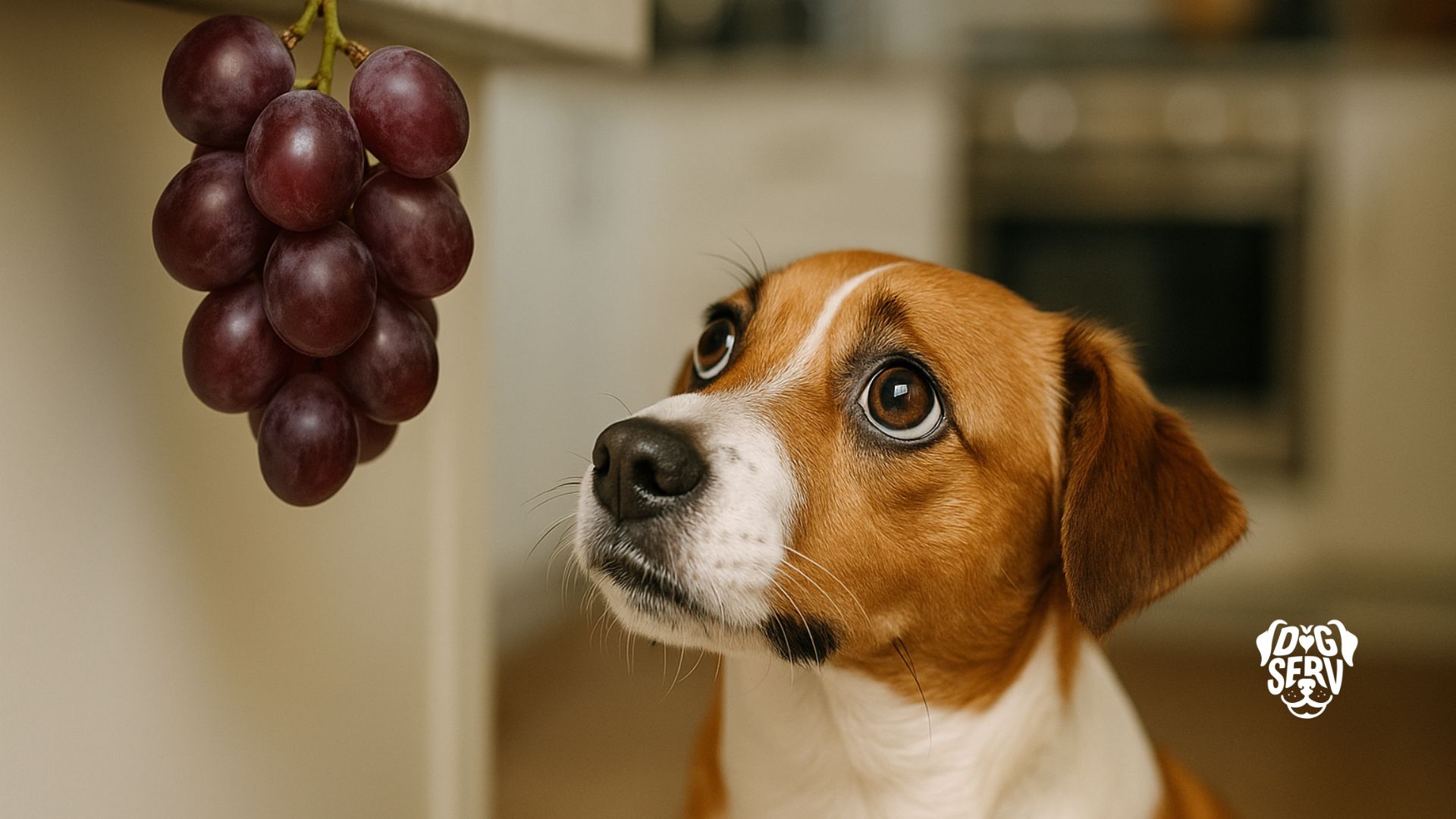
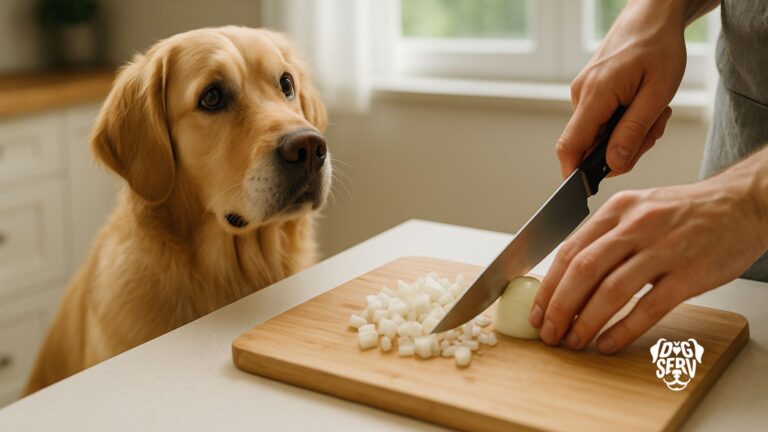
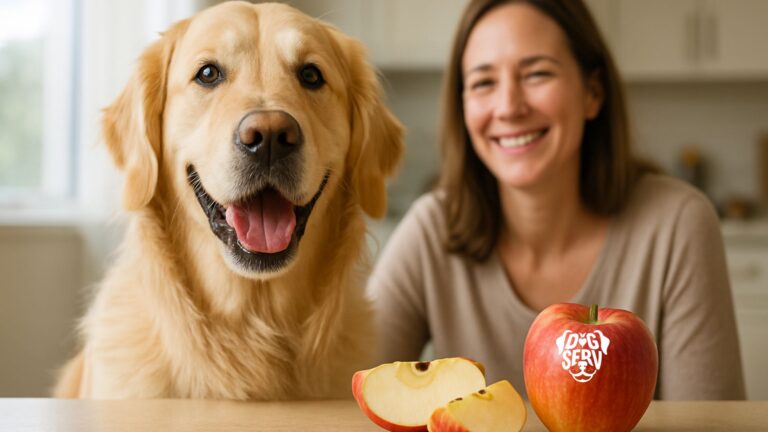
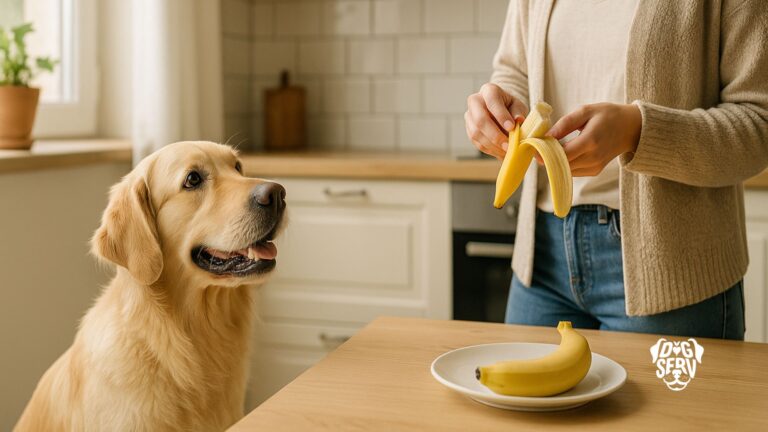
Calvin Hewitt is the primary author and driving force behind DogServ, bringing over 27 years of business expertise and 7 years of specialized digital marketing experience to the dog service industry. As the founder of Web Leveling and architect of DogServ’s evolution from a simple directory to a comprehensive one-stop shop for dog lovers, Calvin has created highly performing dog training websites in competitive markets, developed popular applications like “Can My Dog Eat?” and “Puppy Planning Checklist,” and generated thousands of monthly page views with his dog service content. Based in the Houston area but serving dog lovers and service providers nationally and internationally, Calvin works alongside a dedicated team of seven professionals, combining analytical rigor from his banking and energy industry background with a genuine passion for connecting dog owners, dog lovers, and service providers through quality content, innovative applications, and trusted recommendations.